Unsure about your French table manners? Click Here to download > > How to avoid these 10 food etiquette mistakes !
- Home ›
- Destinations ›
- France Less Visited ›
- Chateau de Maintenon
Chateau de Maintenon and the Astonishing Rise of Françoise d'Aubigné
Published 14 July 2024 by Leyla Alyanak — Parisian by birth, Lyonnaise by adoption, historian by passion
The private residence of the second spouse of Louis XIV is unusual: it is not in the Loire Valley, and its garden has a special feature you won’t find anywhere else. I recently visited and was fascinated by the story of Madame de Maintenon, the king’s wife who would never be queen.
Françoise d'Aubigné rose from utter obscurity to salon celebrity, and from governess to wife of a king.
For a woman born in a debtor’s prison, she did rather well.
NOTE: Pages on this site may contain affiliate links, which support this site. See full Privacy Policy here.
Orphaned early, Françoise d'Aubigné lived with impoverished relatives in rural France, but her fortunes improved when she married poet Paul Scarron.
He introduced her to Parisian society, where he held one of those literary salons so popular during the 17th century. His marriage to Françoise, a bright young thing of 16, attracted all the glitterati of the time.
Françoise, now Madame Scarron, built an impressive network of notables, which included a certain Françoise-Athénaïs de Montespan, who just happened to be the mistress of King Louis XIV and mother of eight of his illegitimate children.
They became friends. When the poet Scarron died, leaving his wife in debt, Madame de Montespan came to the rescue, making sure the widow received a pension and offering her the position of governess to her children.
If only she had known...
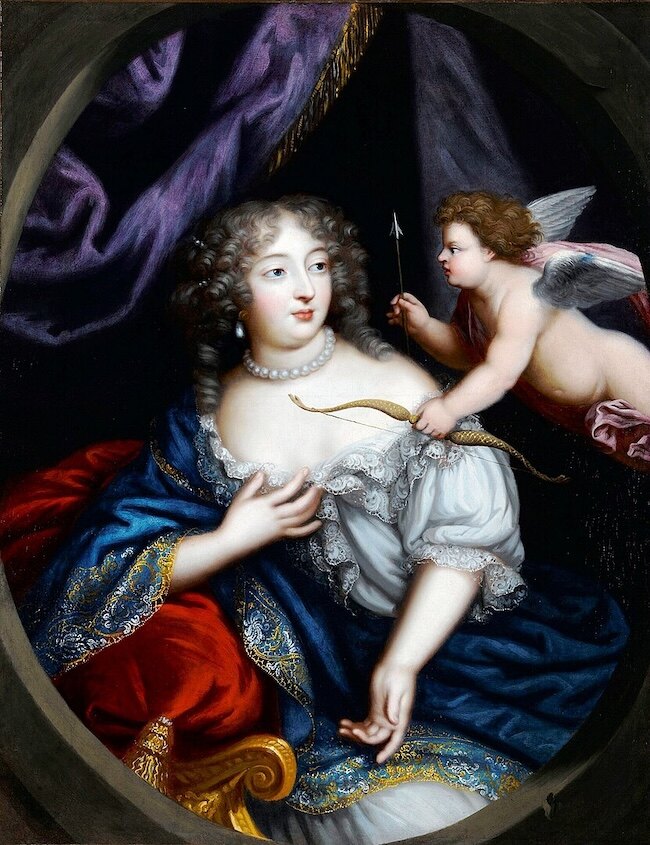 Madame de Montespan, Louis XIV's mistress. By Atelier de Pierre Mignard – Sergey Prokopenko via Wikimedia Commons
Madame de Montespan, Louis XIV's mistress. By Atelier de Pierre Mignard – Sergey Prokopenko via Wikimedia CommonsFrom Scarron to Maintenon
The King began to notice the governess. He was impressed with her devotion to his children, which seemed even greater than that of their mother.
The mistress inevitably grew jealous as she watched the King's growing interest in the governess.
Once good friends, the two women drifted towards conflict. The feud became so bitter that the King even had to intervene occasionally, torn between love for his mistress and affection for his governess.
As an entertaining aside, Madame de Montespan, keen to keep the King away from the governess, brought in an unexpected third party: Mademoiselle de Fontanges, a 17-year-old enchantress who would soon be pregnant but die after childbirth in unusual circumstances.
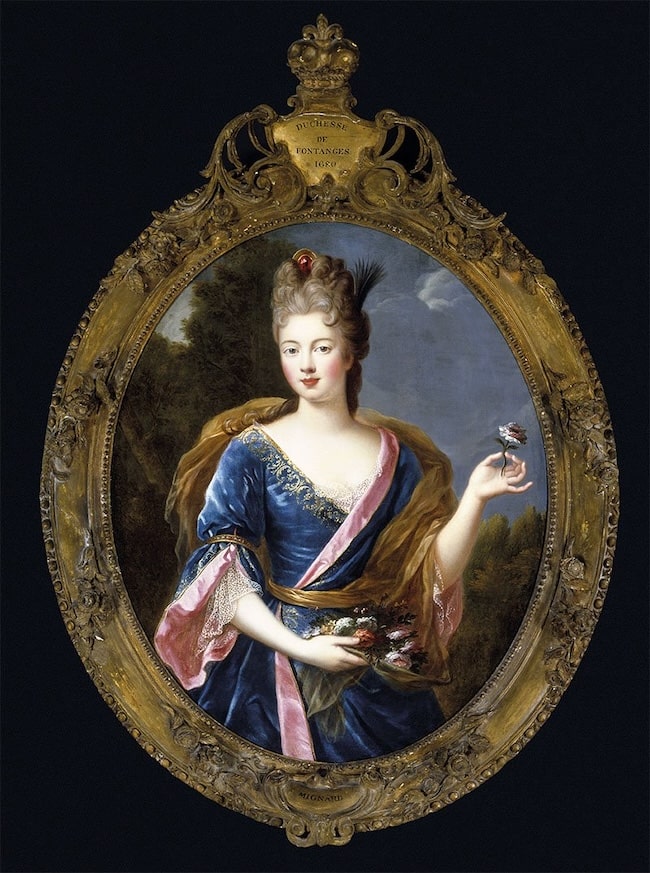 The Duchess of Fontanges. Studio of Pierre Mignard I, Public domain, via Wikimedia Commons
The Duchess of Fontanges. Studio of Pierre Mignard I, Public domain, via Wikimedia CommonsFuture research would confirm the young woman had died of eclampsia, but at the time, rumors flew wildly.
Had she been poisoned? Were devil worship and child sacrifice involved? As her reputation plummeted, Madame de Montespan’s reputed (but unproven) involvement in these events would drive a wedge between her and her royal lover.
Louis, now in his mid-forties, had already started distancing himself from Madame de Montespan and her excessive jealousy, preferring a calmer, more organized life.
In fact, just the kind of life he might find with the governess, Madame Scarron. She was intelligent, calm, pious – all qualities he admired now, later in life.
They began an affair quietly but when his wife, Queen Maria Teresa, died (yes, she had been alive throughout), Louis would turn to Madame Scarron for companionship, and eventually marriage.
Meantime, Madame Scarron, having made a few wise investments (partly financed by a helpful King) bought the Château de Maintenon, acquiring with it the right to be called Madame de Maintenon. The name Scarron would be forgotten, and the name Maintenon would now take center stage.
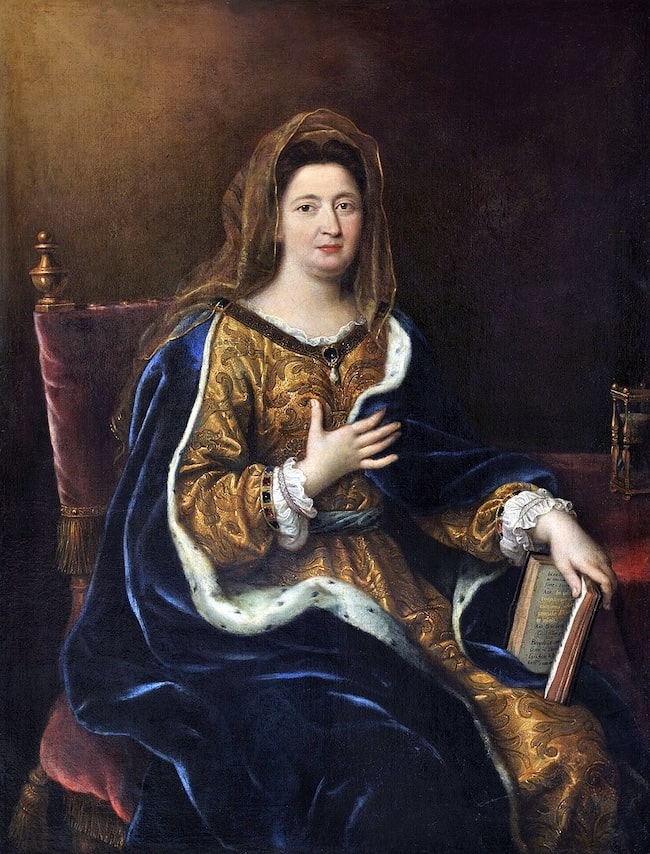 Now, the Marquise de Maintenon, Louis XIV's secret wife. Pierre Mignard I, Public domain, via Wikimedia Commons
Now, the Marquise de Maintenon, Louis XIV's secret wife. Pierre Mignard I, Public domain, via Wikimedia CommonsIn 1683, she would marry the King, but in secrecy: as she was not of royal blood, going public would have scandalized all of Europe. Of course this being court, news of the marriage spread quickly and the secret soon got out. But at least the wedding was discreet and people could pretend it hadn’t happened.
While often cited by historians, this secret wedding remains undocumented. It seems strange that not a single written reference has been unearthed confirming it…
Throughout their marriage, which spanned more than three decades, her quiet influence over Louis XIV grew. Her faith influenced the King, steering him towards a more devout and moral lifestyle, even affecting his policies. But she always stayed discreet, and would be known as the "Shadow Queen."
Madame de Maintenon had another side to her: she was deeply committed to social and educational reform. In 1686, she founded the Saint-Cyr school for impoverished noblewomen. It became a model for female education in France.
The Château de Maintenon
The beautiful Château de Maintenon, which I visited in that period when winter hasn’t quite turned to spring, is located in the département of the Eure-et-Loir, about an hour southwest of Paris.
It started as a solid medieval fortress owned by the Amaury family, its roofless square tower serving as a lookout against attackers.
During the 15th century, it was “improved”, and brick towers were added to its corners. This strengthened defences, but change was creeping in and you could see the emerging influence of the Renaissance.
The Amaury family eventually sold it to Louis XII's treasurer, Jean Cottereau, who would embellish it, but the major modifications would only take place after 1674, when Madame de Maintenon purchased the château.
She built new apartments, which you can visit and which are among the château's main features.
You’ll be able to wander through Louis XIV’s salon (which was once his bedroom).
The extensive library – the books are original, but not the bookcases – contains more than 2000 works, including some of Madame de Maintenon’s own original books.
LIBRARY
SALON DU ROI
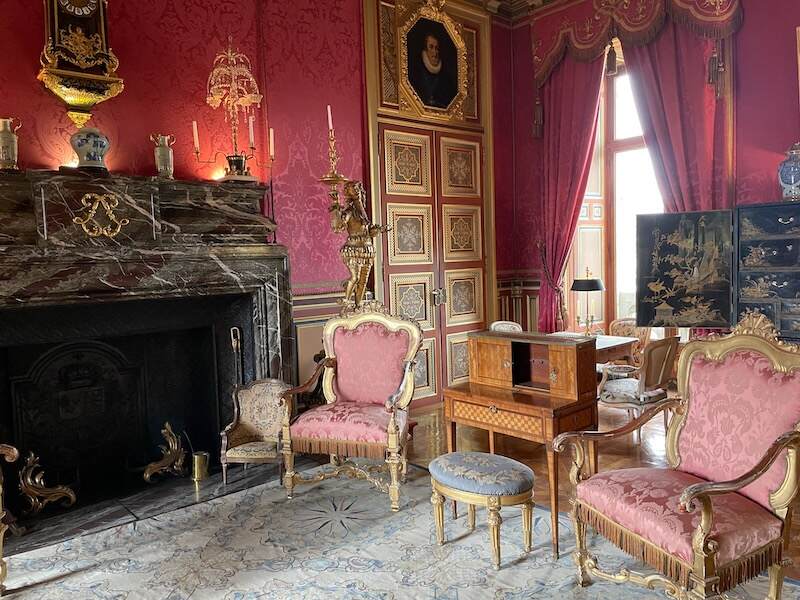
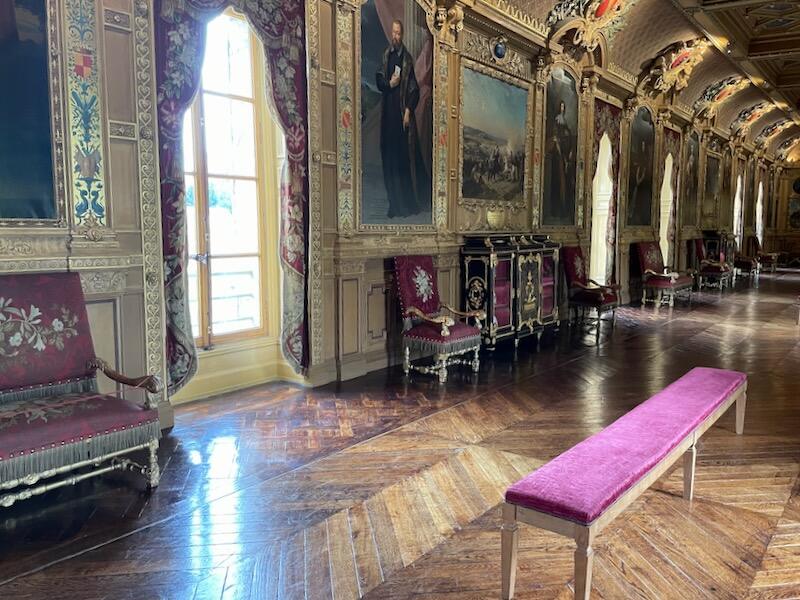
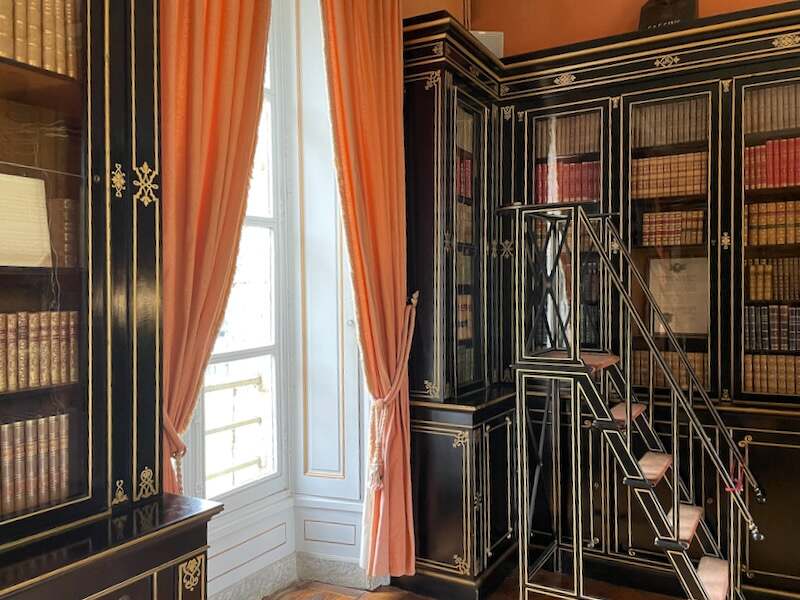 Top: Salon du Roi. Middle: Grand Gallery. Bottom: Library. ©OffbeatFrance
Top: Salon du Roi. Middle: Grand Gallery. Bottom: Library. ©OffbeatFranceThe ownership dance would continue and Maintenon Castle would eventually find its way into the hands of the Duke de Noailles, who would add his own touches, including an attic, the Grande Galerie (inspired by Versailles, apparently) and the outdoor arcades you can still see today. The style would also evolve, into the neo-gothic that was becoming all the rage (gargoyles included).
The royal gardens of Le Nôtre
Madame de Maintenon would have nothing but the best, and the best in landscape architecture at the time was none other than André Le Nôtre, responsible for the gardens of the Château de Versailles.
He designed a beautiful French garden for her, grandiose examples of formal design, with geometric flower beds and symmetrical layouts, and while the approach may indeed reflect that of Versailles, these are obviously on a smaller scale.
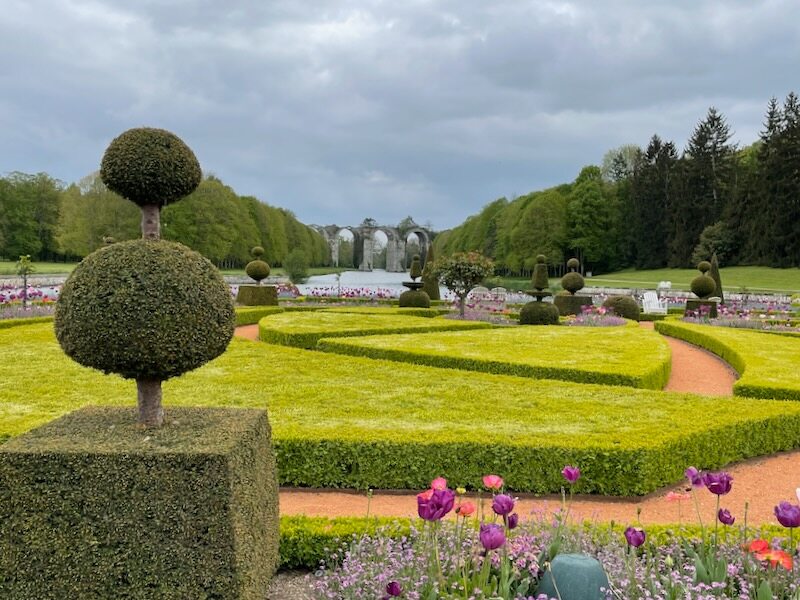 The formal gardens of the Château de Maintenon, created by André Le Nôtre, who created the gardens at Versailles ©OffbeatFrance
The formal gardens of the Château de Maintenon, created by André Le Nôtre, who created the gardens at Versailles ©OffbeatFranceFortunately, Le Nôtre’s original designs are still available from existing historical manuscripts and drawings, and major restoration of the gardens in 2013 was based on these designs.
Vauban’s aqueduct
Much as the gardens are stunning, my favorite feature − and the one that drew me to the castle of Maintenon in the first place − is the ambitious, yet unfinished, aqueduct project initiated by Louis XIV and his military engineer, the Marquis of Vauban. (Vauban is a bit of a hero of mine, having built dozens of fortifications across France, of which 150 remain). In 2008, a network of 12 Vauban sites were admitted to UNESCO’s World Heritage List.
As for the aqueduct, it was one of the many (either unrealistic or failed) schemes designed to bring water to the Versailles gardens, some 80 km/50 mi away. This one would try to divert the waters of the Eure River.
Vauban, ever practical, had suggested a system of underground pipes. The "Sun King", ever grandiose, opted for a giant aqueduct, towering higher in parts than Paris’s Notre-Dame.
Inspired by the Roman Pont du Gard, his structure was supposed to feature three storeys of arches. Instead, financial constraints meant it had to be scaled back to a single row.
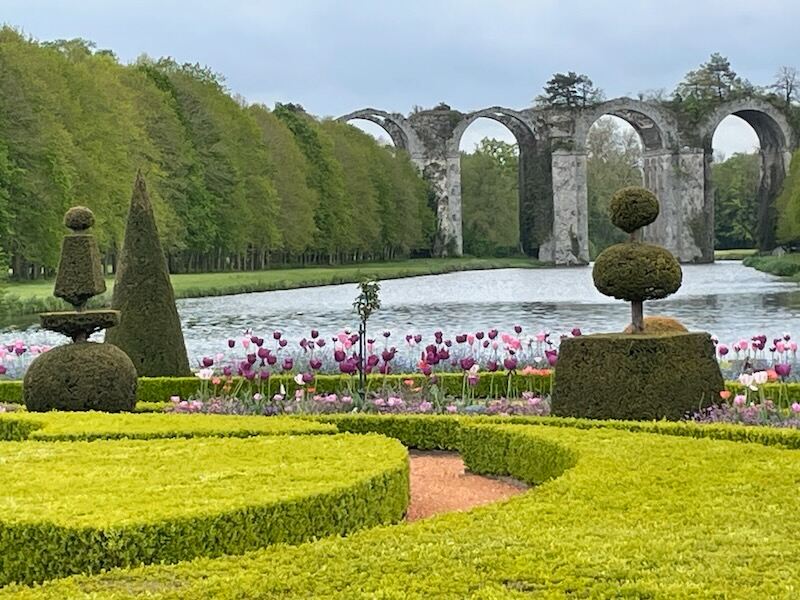 The aqueduct seen from the end of Madame de Maintenon’s garden
The aqueduct seen from the end of Madame de Maintenon’s gardenConstruction began in the late 17th century but came to a halt with the Nine Years’ War, in which European nations joined forces against France.
The money needed for war meant there wouldn't be enough to complete the aqueduct. Not only that, but many of the men working on it would have to leave to fight on the frontlines, draining the construction site's manpower.
Eventually, some 30,000 workers would be involved in the building, many succumbing to fever in the marshlands.
And there it would stand, unfinished, at the far end of the garden. Parts would be reclaimed by nature, and stones would be carted off for use in building.
The King’s wife, Madame de Maintenon, would request (and receive) compensation for the construction: she said it obstructed her view from the château.
She would also receive a new title, Marquise de Maintenon.
But perhaps the most ironic gift would be that of the unfinished aqueduct itself, forever a reminder of a king's folly.
How to visit the Chateau de Maintenon
It’s easy to reach the château by train in less than an hour from Paris, or you can drive up the A10 from Paris in about 1h 30m. It’s an easy day trip so you don’t need to stay the night.
For lunch, try the authentic and reasonable “Aux Deux M”.
You can get more information from the château’s website. If you speak French, you can sign up for a guided tour but there are none in English.
Before you go…
The Eure-et-Loir is an impossibly historical region and beyond Maintenon, you can also visit the castles of Anet and Chateaudun, both of them relatively close to Paris.

